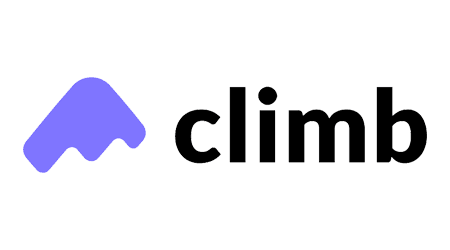Climb Credit student loans review

- APR
- 9.55% to 16.71%
- Max. Loan Amount
- Up to the full cost of tuition
Our verdict
Fund a skills-based program that doesn't qualify for federal aid.
Climb Credit can be a viable option if you're looking to attend a skills-based program like coding bootcamp or a technical school that doesn't qualify for federal aid. It offers traditional student loans as well as risk-share agreements, where the school doesn't receive get your full tuition until after you've landed a job.
However, it's only available if you're attending a school that Climb has partnered with. And APRs run slightly higher than other types of student loans — including a high 5% origination fee. And it's been singled out by a consumer protection group for its high cost.
Not sold on Climb Credit? Check out our list of other student loan providers that might be a better fit.
Details
Product details
| Product Name | Climb Credit |
| Max. Loan Amount | Up to the full cost of tuition |
| APR | 9.55% to 16.71% |
| Interest Rate Type | Fixed |
| Requirements | Attend eligible school, US citizen or permanent resident, legal age of majority in your state, not live in Rhode Island |
- Attend an eligible school
- Resident of an eligible state
- US citizen or permanent resident
- Age of majority in your state of residence
- Available for skills-based programs. If you don’t attend a Title IV school, Climb Credit could still be an option.
- Vets your school. Climb Credit considers factors like a school’s graduation rate and job placement before working with a school.
- Incentivizes your success. The risk-share agreement gives schools a financial incentive to help you find a job after you graduate.
- Available to international students and minors. You can apply regardless of your citizenship or age if you have a creditworthy cosigner.
- Only available through partner schools. If your school doesn’t offer Climb Credit student loans, you can’t apply.
- Not available in Rhode Island. Climb Credit is currently working on licensing to work with borrowers in this state.
- Origination fee. Most private student loan providers don’t charge an origination fee, but Climb borrowers must pay 5% of the loan amount.
- High repayments on 0% interest loans. While signing up for the pathway payment program might be tempting, make sure you can afford the high monthly repayments to avoid defaulting.
- Go to the Climb Credit website. Click Get a loan.
- Enter your school’s name and click Go.
- Enter your contact information and click Get started.
- Follow the instructions to fill out the application with information about yourself, the loan and your cosigner if applicable.
- Read the disclosures and review your answers before submitting your application.
- Contact information
- Social Security number
- Proof of residency
- Proof of employment — only for cosigners
-
-
-
First, am I eligible?
To qualify for a Climb Credit student loan, you must meet the following criteria:
Students who can’t meet age, citizenship or residency requirements can still qualify if they apply with a cosigner. Climb Credit also considers factors like your credit score, debt-to-income ratio and the school you attend.
What states is Climb Credit available in?
Climb Credit is currently available to residents of all 50 states except Rhode Island.
What is Climb Credit?
Climb Credit is a student loan provider that offers financing to students through schools that offer skills-based training programs. It serves to fill a gap in the student loan market, Climb Credit Founder and CEO Angela Ceresnie told finder.com during the 2019 LendIt Fintech USA conference.
“It doesn’t really make sense for schools that are charging $10,000 or $15,000 to have federal financial aid because it’s a very expensive program to administer,” she said. “But you don’t want to not offer financial aid, because then people have to come up with $10,000 or $15,000 in cash, which is not always possible. So Climb is sort of a good in-between.”
How does Climb Credit work?
Climb Credit works by partnering directly with schools after evaluating the graduation rate and employment numbers of its former students. The schools in turn offer Climb Credit funding to their students through their financial aid department.
Risk-share agreements
In some cases, it also gives some schools an incentive to help students find a job through what Ceresnie calls a risk-share agreement. Here, the school doesn’t receive full tuition until after you land a job and start making full repayments. So if you borrowed $10,000, the school might only receive $8,000 up front and the remaining $2,000 as you pay off your loan.
“The idea there is aligning [students’] interests with the school and bringing the schools into a place where they have a financial upside to their students actually doing well in the job market,” Ceresnie said.
How much do Climb Credit student loans cost?
Climb Credit student loans come with fixed interest rates that run from 6% to 14%, plus an origination fee of 5%. That works out to an APR of up to 16.71% — higher than most private loans, which cap out at around 13% APR. But if you sign up for the short-term pathway payment program, rates start at 9.55% APR.
Loan amounts and terms vary depending on your school, though typically students take three years to pay it back. Use the calculator below to see how much your loan might cost you per month, based on the rate you expect to receive.
If you choose a repayment plan that allows you to make interest-only repayments while you’re in school or unemployed, your total loan cost will be higher. Climb also considers factors like your credit score and debt-to-income ratio when underwriting your loan.
Is Climb a “shadow lender”?
A July 2020 study by the Student Borrower Protection Center (SBPC) included Climb as part of a group of high-cost “shadow lenders,” which the SBPC claims are used to prop up predatory for-profit schools. It singled out Climb specifically for charging APRs as high as 34.68%.
When I reached out to ask about this, a Climb representative clarified the 34.68% APR came from a student that had a low cost of attendance and extremely short loan term, which can make the cost of a loan higher.
“For 94%+ of our loans, APRs range from 0% to 18.99%,” they said.
Does Climb Credit offer any discounts?
Yes, Climb Credit offers a 0.25% rate discount if you sign up for automatic repayments.
What are my repayment options?
Climb Credit offers different repayment programs through different schools. While repayments start one month after your school receives the funds, you can typically make interest-only repayments until you graduate. In some cases, you might even be able to make interest-only repayments until you find a job in your field. Repayment plans often run from three to five years.
Pathway payments
Climb also offers 0% interest to students who agree to repay the loan in the short term. These typically come with terms of 12 to 24 months, so you’ll have higher monthly payments. It could be a good option if you anticipate getting hired at a salary high enough to afford repayments. But use a calculator to see how much your loan will cost you before you sign up. Otherwise you risk going into default.
Contact your school’s financial aid office to learn more about the repayment options available to you.
Top reasons to consider Climb Credit
From its risk-share agreements to its cosigner-friendly loans, here are a few perks of borrowing from Climb Credit:
Drawbacks to borrowing from Climb Credit
Consider these potential drawbacks before taking out a loan from Climb Credit:
Climb Credit reviews and complaints
| BBB accredited | No |
|---|---|
| BBB rating | C+ |
| BBB customer reviews | |
| Trustpilot Score | 4.3 out of 5 stars, based on 137 customer reviews |
| Customer reviews verified as of | 16 October 2020 |
What to expect when signing up
Since Climb Credit directly partners with schools, the application process can vary from school to school. “Sometimes the application is available online through the school’s financial aid website, sometimes it’s available directly on the application,” Ceresnie said.
You can also apply through the Climb Credit website. Here’s how that works:
Typically, it takes less than five minutes to complete the application if you have all of the information you need on hand. After you submit your application, you should receive an offer from Climb Credit. If you accept the rates and terms, sign the loan documents and submit it along with any required documents.
What information do I need to apply?
To apply for a Climb Credit student loan, you might need the following information for you or your cosigner:
Who services Climb Credit student loans?
University Accounting Service (UAS) handles all repayments on Climb Credit student loans. This means you’ll get your first bill through UAS and sign up for autopay through the servicer, not Climb Credit, to get that 0.25% rate discount. If you have any questions about repayment, contact UAS’s customer service team at 800-999-6227.
More about Climb Credit
Climb Credit has a couple more student loan products in the pipeline, according to Ceresnie. One is a 0% interest loan, where the school subsidizes your interest payments. Climb Credit plans on launching that in the near future.
Another is a loan with an insurance component. With this option, the loan doesn’t kick in until students get a job in exchange for a slightly higher-cost loan.
Check out our guide to student loans to compare lenders and find the best rates.
Frequently asked questions
Student loan ratings
★★★★★ — Excellent
★★★★★ — Good
★★★★★ — Average
★★★★★ — Subpar
★★★★★ — Poor
We rate student loan providers on a scale of 1 to 5 stars based on factors like transparency, costs and customer experience. We don’t take into account elements like eligibility criteria, state availability or payment frequency — we save that for our reviews.
Your reviews
Anna Finder
Editor
You are about to post a question on finder.com:
- Do not enter personal information (eg. surname, phone number, bank details) as your question will be made public
- finder.com is a financial comparison and information service, not a bank or product provider
- We cannot provide you with personal advice or recommendations
- Your answer might already be waiting – check previous questions below to see if yours has already been asked
Finder only provides general advice and factual information, so consider your own circumstances, or seek advice before you decide to act on our content. By submitting a question, you're accepting our finder.com Terms of Use and Privacy and Cookies Policy.
